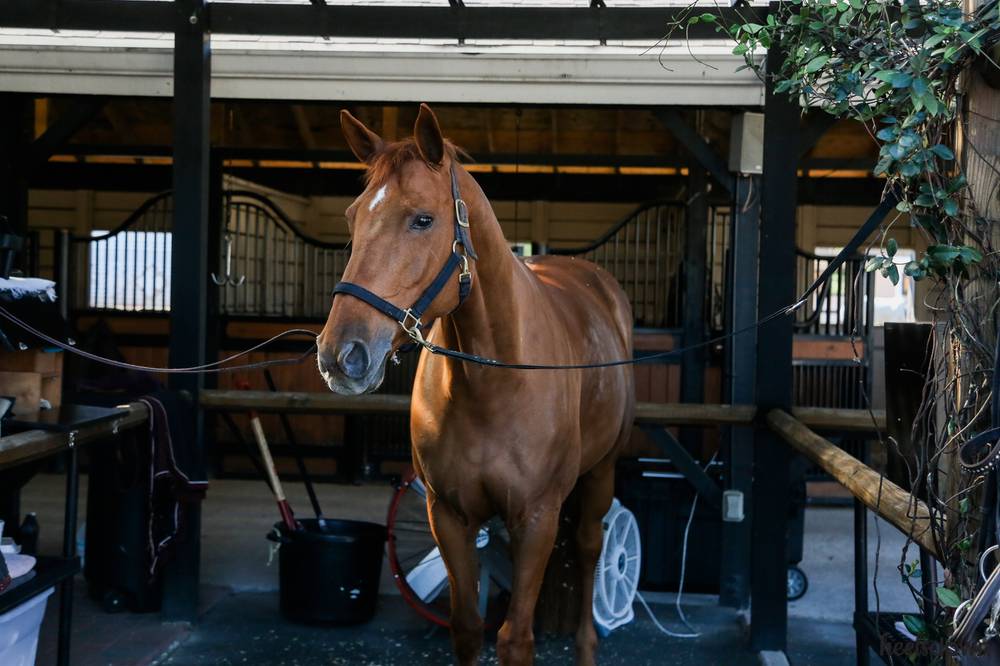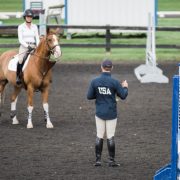The Many Emotional Stages Of Rehabbing A Horse

It’s the worst string of words for any equestrian to hear: “stall rest, followed by months of rehab.”
Your show season comes to an abrupt end. The future of your riding career with your equine partner may be in jeopardy. Weeks feel like months and months feel like years. Rehabbing injuries, from soft tissue to surgery recovery, can feel like the worst kind of purgatory.
I’m in the thick of it now, rehabbing my Thoroughbred gelding who suffered a suspensory injury. We’re only a few months in and I feel like I’ve experienced a wide range of emotions already. I’m coming to learn there are “stages” one goes through during an injury/recovery/rehab process. Bear with me as I try to outline them for you here.
Grief.
Naturally, the shock of the injury hits you right in the face. Quickly the grief sets in. Your world is ending. How will you go on without being able to ride your horse? You try to think that well, it could be worse. They could be dead… then you try to trick your brain into not going to that dark of a place ever again. So you settle into your grief. You cry at the barn. You cry in your car. You cry ringside when your trainer is giving lessons. You cry at home over a bottle of wine and tub of ice cream. You. Feel. Everything.
Hope.
It’s time for your first scans after weeks of rest and treatment. God, you’re so nervous. What if the ultrasound reveals no healing at all? What if it’s worse?!?!! Your vet does their best to temper your feelings and expectations. It’s not like you really know what you’re looking at anyway, with the squiggly lines and stretchy spots. But enough time has passed to show some semblance of healing and thank the Lord, this is the best news you’ve ever gotten in your life. Better than when your husband proposed. Better than the birth of your child. But you’re not out of the woods yet.
Dread.
Finally, your horse graduates from stall rest and can handle short hand walks and isolated paddock time. You should feel elated – this is progress. It’s all moving in the right direction. But your horse, who has been stuffed in a box for far too long, has other plans. He comes out the first day like a fire-breathing dragon. The sedative the vet prescribed to keep him mellow and all four feet on the ground is having the opposite effect, it seems. Your horse is a kite, and still a dragon, and you’re just along for the ride at the other end of the lead rope. Hang on tight!!!!
When you finally feel like you’ve built up the courage to turn him out in said small paddock, you hold your breath as you slip off his halter and pray he makes good decisions. He promptly does not. And right then and there, another grey hair (or two) sprouts from your scalp.
Frustration.
Those first few days of walking and turnout time go awry. You face setbacks – some inflammation is back and more scans show fluid build up. The vet waffles on whether your horse should be stuffed back in the box for a few more weeks. You feel awful and guilty and frustrated. You waste hundreds of dollars on unproven therapies and supplements that he’s just going to pee out. Will you ever get out of this stall rest hell? Will you ever ride again? Will you ever find happiness again in this lifetime? Will you ever escape the upside-down?
Pure Bliss.
Luckily the bad boy hand walks and turnout antics die down and you find a rhythm and understanding with your injured horse. In just a few days/weeks it feels like the tide is turning in your favor and you are grateful. The time you spend on the ground with your horse becomes your reprieve. You’re bonding with him in a new way you didn’t think was possible. Maybe, just maybe, you’ll get through this tough time together.
Paranoia.
It’s time for more scans. The vet is pleased with your horse’s progress and grants you the opportunity to put a saddle on his back again. But not so fast – you’re only walking under tack for five minutes at a time. In a few weeks, it will be 10 minutes. No turns. No lateral work. No soft footing. The driveway to the farm becomes your new home. Five minutes always feels like it goes by too fast. You worry that perhaps this is happening too soon. What if the weight of you and your middle-aged amateur glory is too much, and this is it, the moment you do him in. Should he go back in the box? You ice his legs incessantly after every 5-minute hack. Your friends at the barn are scared to talk to you, you’re so jumpy. Even your horse is like, “wtf, chill dude.”
Cautious Optimism.
You keep walking, even though with every clip-clop down the driveway, you expect him to crumple onto the ground. Weeks pass and the vet returns. He’s still healing. It’s going in the right direction. You can trot for longer now. The hopes of completing one full 20-meter circle are on the horizon. The vet is encouraging, he tells you to keep going. So you do. Even if you cry sometimes and scream into the void that is your empty car on the way home. You’re almost there, you tell yourself. Stay the course. The two of you just might climb your way out of this after all.
Love.
It’s healed. You can’t believe it. Your horse is cleared to go back into work. The moment these words come out of your vet’s mouth, it’s like an out-of-body experience. You’re floating above yourself right then, watching yourself stare stupidly back at your vet in disbelief. But it’s real. You made it. You book a lesson – A REAL LESSON – with your trainer again. Though you’re nervous, and you know 100% you’re going to play it safe and stay in Long Stirrup Land for far too long, you’ve never felt relief like you do now, knowing your horse is healthy and he made it. You both made it. You’re on cloud nine. Everything is perfect. Everyone around you is grateful too, that you can finally behave like a Real Functioning Adult again.
You did indeed, escape the upside-down.


